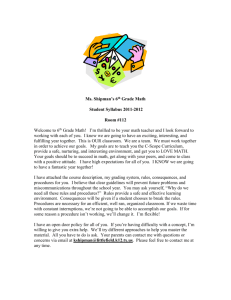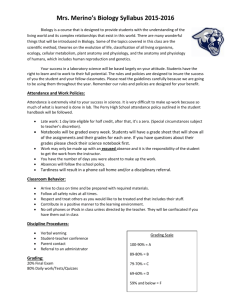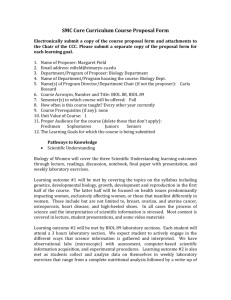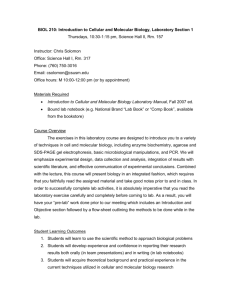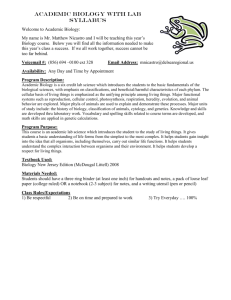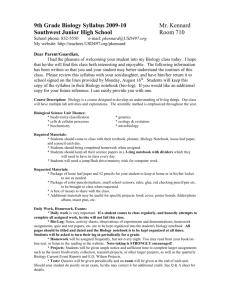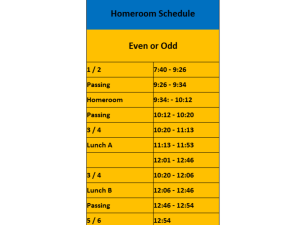Syllabus - Biosbcc.net
advertisement
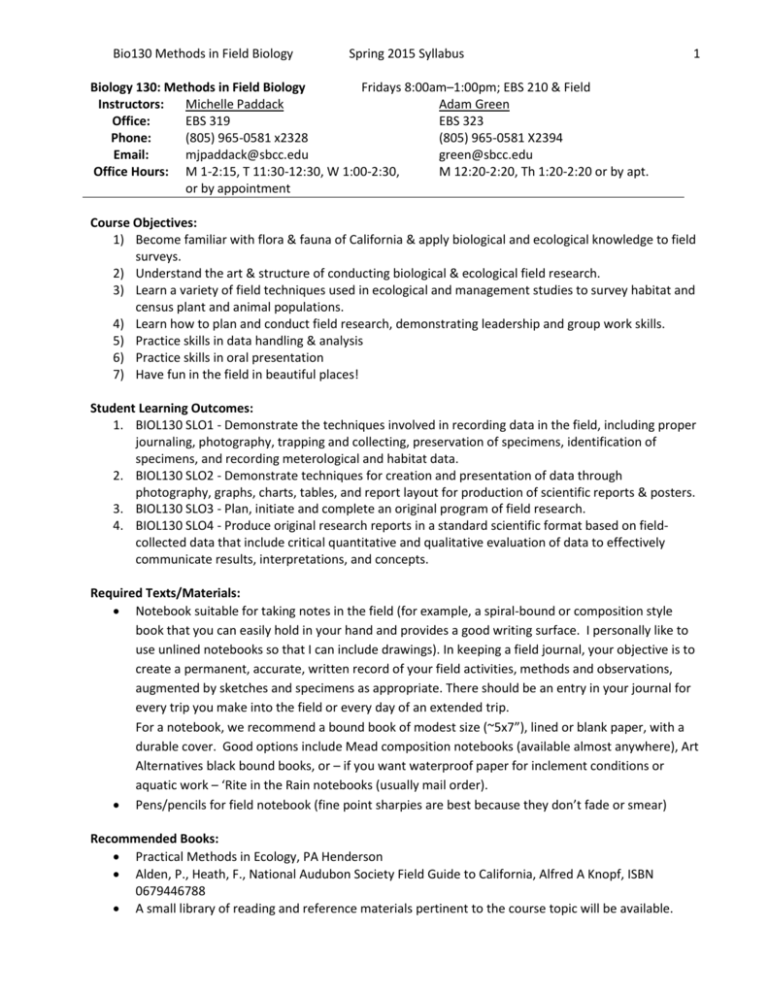
Bio130 Methods in Field Biology Spring 2015 Syllabus 1 Biology 130: Methods in Field Biology Fridays 8:00am–1:00pm; EBS 210 & Field Instructors: Michelle Paddack Adam Green Office: EBS 319 EBS 323 Phone: (805) 965-0581 x2328 (805) 965-0581 X2394 Email: mjpaddack@sbcc.edu green@sbcc.edu Office Hours: M 1-2:15, T 11:30-12:30, W 1:00-2:30, M 12:20-2:20, Th 1:20-2:20 or by apt. or by appointment Course Objectives: 1) Become familiar with flora & fauna of California & apply biological and ecological knowledge to field surveys. 2) Understand the art & structure of conducting biological & ecological field research. 3) Learn a variety of field techniques used in ecological and management studies to survey habitat and census plant and animal populations. 4) Learn how to plan and conduct field research, demonstrating leadership and group work skills. 5) Practice skills in data handling & analysis 6) Practice skills in oral presentation 7) Have fun in the field in beautiful places! Student Learning Outcomes: 1. BIOL130 SLO1 - Demonstrate the techniques involved in recording data in the field, including proper journaling, photography, trapping and collecting, preservation of specimens, identification of specimens, and recording meterological and habitat data. 2. BIOL130 SLO2 - Demonstrate techniques for creation and presentation of data through photography, graphs, charts, tables, and report layout for production of scientific reports & posters. 3. BIOL130 SLO3 - Plan, initiate and complete an original program of field research. 4. BIOL130 SLO4 - Produce original research reports in a standard scientific format based on fieldcollected data that include critical quantitative and qualitative evaluation of data to effectively communicate results, interpretations, and concepts. Required Texts/Materials: Notebook suitable for taking notes in the field (for example, a spiral-bound or composition style book that you can easily hold in your hand and provides a good writing surface. I personally like to use unlined notebooks so that I can include drawings). In keeping a field journal, your objective is to create a permanent, accurate, written record of your field activities, methods and observations, augmented by sketches and specimens as appropriate. There should be an entry in your journal for every trip you make into the field or every day of an extended trip. For a notebook, we recommend a bound book of modest size (~5x7”), lined or blank paper, with a durable cover. Good options include Mead composition notebooks (available almost anywhere), Art Alternatives black bound books, or – if you want waterproof paper for inclement conditions or aquatic work – ‘Rite in the Rain notebooks (usually mail order). Pens/pencils for field notebook (fine point sharpies are best because they don’t fade or smear) Recommended Books: Practical Methods in Ecology, PA Henderson Alden, P., Heath, F., National Audubon Society Field Guide to California, Alfred A Knopf, ISBN 0679446788 A small library of reading and reference materials pertinent to the course topic will be available. Bio130 Methods in Field Biology Spring 2015 Syllabus 2 Field Excursions On most class meetings, we will begin & end class at a local field site. Many of these sites, including the two long weekend camping trips, will be reserves operated as part of the UC Natural Reserve System. Visits are limited to university-level research and education and not fully open to the public. We are able to visit and stay at these reserves under a special permit. There are on-going studies and restoration projects occurring here, so it is imperative that you respect restricted areas & conduct yourself professionally. For the long weekends, we will be camping in wilderness areas. There is a kitchen/meeting area, showers and outhouses. Alcohol & illegal drugs are not permitted. Information and location of the reserves we will be camping at can be found on these websites: Big Creek UC Nature Reserve: http://bigcreek.ucnrs.org/description/index.html Santa Cruz Island: http://santacruz.nrs.ucsb.edu/visiting/facilities-equipment-field-station Transportation: We will be visiting local field sites, some with limited parking so car-pooling will be imperative. On the long weekends, group transportation via vans or bus will be provided. Clothing: We will be working in a variety of local field sites including chaparral, forest, rocky intertidal, mudflats, marshes, open fields. Wear clothes appropriate for use in the field including: sturdy, comfortable shoes, sunhat, sunglasses, long pants, jacket. Bring clothes that will protect you from thorns, poison oak, and insect bites. Be prepared to get wet and dirty. Also see equipment list (http://biosbcc.net/bio130/Equipment%20List.htm) Research Equipment We will be using a wide range of research equipment – from transect tapes to binoculars to computers. This only works if we all take responsibility for caring for it, and making sure it gets put back so that others can use it. Be conscientious. Also, it is common that equipment breaks or needs maintenance. We won’t yell at you or charge you extra for breaking stuff (unless it’s been gross negligence!). Don’t put away a damaged or non-functional piece of equipment. Give it to us so that we can fix it or replace it. Grading Scheme Activity Participation Field Journal TA for the day Group Research Proposal Presentation Total % of grade 19% 25% 19% 38% 100% Point Value 150 (15 field exercises at 10 pts each) 200 150 300 800 Assignment Details: 1. Participation: Students will be evaluated on their level of participation and engagement in each lecture and field activity. Participation and attendance is more than just showing up. It involves helping set up exercises, collecting data, participation in planning sessions, participating in class discussions and helping your fellow students. Participation includes demonstrating active involvement in class activities. The assignment of points will be the result of a combination of observations made by your instructors and the observations and input of your fellow classmates. 2. Field Journal: Students are required to write and turn-in field notes in an organized notebook (don’t forget to put your name on it!). (see grading rubric: http://biosbcc.net/bio130/Field%20Notebook.htm) Bio130 Methods in Field Biology Spring 2015 Syllabus 3 A lesson on field note techniques will be given in the first lecture and you will be given feed-back on your notebooks during the semester. You will be expected to take notes on each activity. Your field notebook must include the following: a) Field notes – details about site, activity, species observed, etc. b) Questions – for each entry, you must write a minimum of 2 questions. c) Notations – after each field activity, you must go back over your notes, elaborating on details and including details of information you looked up during/after the trip that provide information in addition to what you observed/experienced. Your notebook will be graded and returned to you during the final class meeting. A rubric for notebook grading is included at the end of this syllabus. 3. TA for the Day: (see grading rubric: http://biosbcc.net/bio130/TA%20Rubric.htm) Each student will have the opportunity to be a group leader on one of the field excursions. The student will research the techniques to be used in the field and teach that technique to their group. The assignment consists of the following: a) A write-up will be due one week prior to day consisting of a. step by step instructions on collecting data including necessary equipment, b. notes on the benefits & limitations of the particular technique, c. the utility of this technique for other ecosystems, b) Acting as a team leader for a group of students during the field excursion. During this time you must ensure that your team is conducting the research correctly and working well together. c) Collection of all data collected by your team. You must go over each datasheet with each data collector to ensure that the data is accurate and readable. d) Entry of data into an Excel file. e) Provide a post-trip write-up that includes the data, brief analysis of it, and a summary of the trip including what worked, what the challenges were to quality data collection. Research Proposal & Presentation: Students will work in teams of 2-4 to create a proposal for a project that involves collection of data in the field. The project will be presented orally to the class at the end of the semester and will be considered your final exam. You will have 15-20 minutes for this presentation. Each person in the tam is required to contribute and present the project. Your project must involve the following sections: a) Research question & hypothesis: come up with a question that is testable and present it as a hypothesis (for example, “Butterflies at Ellwood will be in their highest abundance during the warmest part of the spring season”) b) Justification for why this question is of interest: This can be short, but the goal is to “sell” your idea – why would someone want to fund you to do this study? How will it advance our knowledge about this system or others? c) Background & Methods: This will be the most detailed portion. Describe in detail exactly how and where you will conduct your research. You must refer to at least 2 published scientific papers or relevant ‘grey literature’ documents (i.e., government/organization handbooks) that have used this method. Discuss why this is the best method. Discuss the constraints of the method. d) Logistics: Provide a list of all field equipment you would need, the locations of your study, how often you would need to visit the sites, and the duration of your study. In a true proposal, this would also be where your budget would be derived from, which would include purchase of equipment, gear rental, and money to pay yourself and helpers for both time in the field and data entry. Bio130 Methods in Field Biology Spring 2015 Syllabus 4 e) Predictions: what do you expect to find? You may want to create a general graph showing what you think your data would look like. What would it look like if your hypothesis was incorrect – would the data you collected allow you to still provide insights into the question? f) Preliminary Data/Proof of Concept: Provide some preliminary data & basic analyses of it (e.g., graphs) to show that your idea is workable (we will provide you with time and equipment during the semester to collect this data). You will also be graded on group work and presentation skills (audible, well-explained, visuals to aid in explanation, teamwork ability, ability to answer questions).

